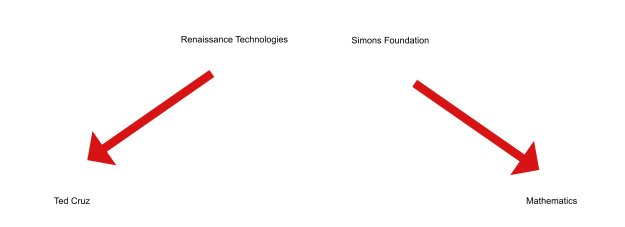
A dilemma’s “outer horn,” in the language of infinity-categories
James Simons — differential geometer, founder of the hedge fund Renaissance Technologies, and co-founder of the Simons Foundation — has been called “reclusive” and “highly secretive” but his name was in the news the other day. MWA states (almost) explicitly that the Simons Foundation’s support has been unequivocally beneficial for mathematics, and this explains the red arrow on the right of the above diagram. From p. 105:
Simons is clearly as concerned as any mathematician, physicist, or biologist about the internal goods of their respective fields. His foundation bases its decisions on the advice of those within the fields who share these concerns.
and more generally, speaking of Simons as well as the Clay Mathematical Institute and the American Institute of Mathematics:
Whatever can be said about the sources of their generosity, the immediate effects of this kind of philanthropy on mathematics have been uniformly positive.
The “source” of the Simons Foundation’s “generosity” in the application of mathematics to finance is subjected to some scrutiny in MWA, but the broader point being made in these pages is rather this one:
The deeper irony is that the (ostensibly) democratically-based social institutions of government are perceived as less sympathetic to the “internal goods” of mathematical practice than the structures of megaloprepeia endowed by Powerful Beings like Clay, AIM, or Simons.
Now we can read in the Guardian that Simons earned $1,700,000,000 (approximately) in 2015 and that he is
the 50th richest person in the world, according to Forbes. His earnings last year were so large that if he were a country it would rate as the world’s 178th most productive nation, according to the World Bank’s GDP rankings.
No surprise there; but consider the Guardian‘s claim that Simons, along with fellow billionaire Kenneth Griffin of Citadel, “poured a lot of money into the presidential race, but both backed Republicans who dropped out.” Specifically, Griffin
in 2012 … described himself as a “Reagan Republican” and said he thought the rich had “insufficient influence” on the political process.
Renaissance, meanwhile,
which is run from the tiny Long Island village of Setauket where Simons owns a huge beachfront compound, has donated $13m to Cruz’s failed campaign. With Cruz out of the race, Renaissance has switched donations to Hillary Clinton, with more than $2m donated so far. Euclidean Capital, Simon’s family office, has donated more than $7m to Clinton.
This explains the red arrow on the left of the diagram. The Guardian article added that Simons “has donated millions of dollars to maths and science education via the Simons Foundation he set up in 1994,” which suggests, perhaps erroneously, an isomorphism between the two terms at the top of the diagram. If the left-hand arrow were a weak equivalence, we would then be able to give an affirmative answer to the question in today’s title. However, the article asserts that Renaissance is good for Cruz, not the other way around; and the first thing one learns about ∞-categories is to make the distinction between inner horns, which can be completed to simplices, and outer horns, like the one in the diagram, which (in general) cannot.
Homotopy-theoretic considerations aside, I find it prima facie implausible that Renaissance, not to mention Simons, would have supported Ted Cruz. Unlike Cruz, the Simons Foundation is concerned about climate change; unlike Cruz (or at least his father), the Simons Foundation believes in evolution. So what’s going on?

I’m not clear, are you saying the Guardian article must be wrong, or just doesn’t make sense, or does it imply that Simons simply doesn’t have full control over how Renaissance spends its money?
LikeLike
I don’t know the Guardian’s sources. The article claims that Simons donated $13 million to Cruz, which seems inconsistent with the priorities of the Simons Foundation; but then it states that the donation came from Renaissance. I don’t know what to conclude; and what do I know about hedging?
LikeLike
Googling the phrase “renaissance technologies cruz” reveals that it is Robert Mercer, co-CEO at Renaissance, who is a Cruz supporter. The New York Times, for example, has an article about him from April of this year, including (by way of comparison) the sentence “Mr. Simons has been a major political backer of Democrats, donating $8.3 million in 2014.”
LikeLike
That’s a relief, and it seems to me the Guardian owes Simons an apology. Mercer is a computer programmer, not a mathematician. Also described as “reclusive,” like Simons; being “reclusive” seems to be part of the job description. What that means, apparently, is “not overly eager to talk to the press.”
LikeLike
It looks like the $13 million for Cruz’s Super PAC came from one specific Renaissance employee. Here’s an article about him (which I haven’t read yet): http://www.bloomberg.com/politics/features/2016-01-20/what-kind-of-man-spends-millions-to-elect-ted-cruz-
All of this campaign funding information is publicly available: http://www.fec.gov/finance/disclosure/advindsea.shtml Simons himself was the big contributor to the Hilary Super PAC (back in 2012, although maybe more recent donations haven’t shown up on the site yet)
LikeLike
Available to the public, and therefore to the Guardian’s journalists.
LikeLike
Yeah, it looks like the Guardian writer got their information from the OpenSecrets website, which aggregates the FEC data, but didn’t read the disclaimer at the bottom of the page:
“The money came from the organizations’ PACs; their individual members, employees or owners; and those individuals’ immediate families. At the federal level, the organizations themselves did not donate, as they are prohibited by law from doing so.”
LikeLike
Supporting Cruz at that point may have been more of an attempt to ward off a Trump nomination, but as other people have pointed out, we *do* know who the money came from.
LikeLike
Pingback: Hedge fund wealth + Big Data = Mind Control | Mathematics without Apologies, by Michael Harris